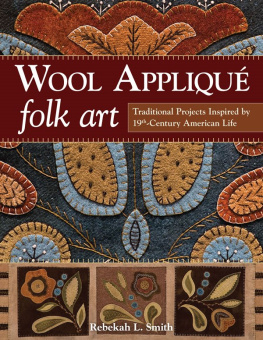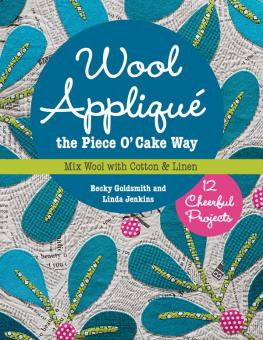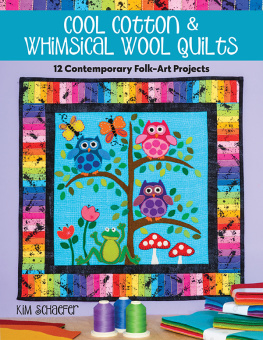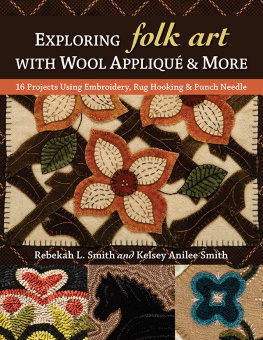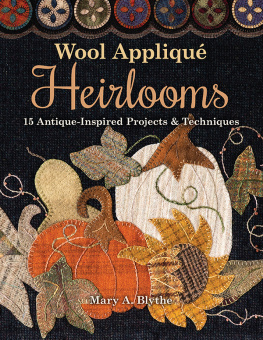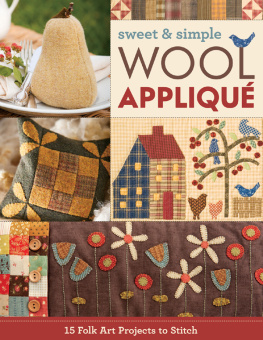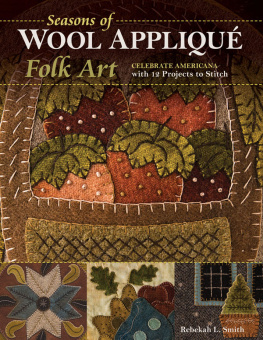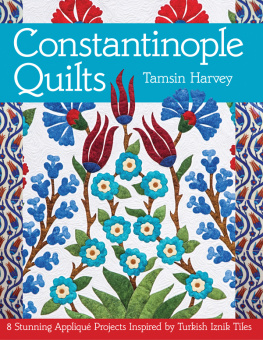Rebekah L. Smith - Wool Appliqué Folk Art: Traditional Projects Inspired by 19th-Century American Life
Here you can read online Rebekah L. Smith - Wool Appliqué Folk Art: Traditional Projects Inspired by 19th-Century American Life full text of the book (entire story) in english for free. Download pdf and epub, get meaning, cover and reviews about this ebook. year: 2015, publisher: C&T Publishing, genre: Home and family. Description of the work, (preface) as well as reviews are available. Best literature library LitArk.com created for fans of good reading and offers a wide selection of genres:
Romance novel
Science fiction
Adventure
Detective
Science
History
Home and family
Prose
Art
Politics
Computer
Non-fiction
Religion
Business
Children
Humor
Choose a favorite category and find really read worthwhile books. Enjoy immersion in the world of imagination, feel the emotions of the characters or learn something new for yourself, make an fascinating discovery.
- Book:Wool Appliqué Folk Art: Traditional Projects Inspired by 19th-Century American Life
- Author:
- Publisher:C&T Publishing
- Genre:
- Year:2015
- Rating:3 / 5
- Favourites:Add to favourites
- Your mark:
- 60
- 1
- 2
- 3
- 4
- 5
Wool Appliqué Folk Art: Traditional Projects Inspired by 19th-Century American Life: summary, description and annotation
We offer to read an annotation, description, summary or preface (depends on what the author of the book "Wool Appliqué Folk Art: Traditional Projects Inspired by 19th-Century American Life" wrote himself). If you haven't found the necessary information about the book — write in the comments, we will try to find it.
Rebekah L. Smith: author's other books
Who wrote Wool Appliqué Folk Art: Traditional Projects Inspired by 19th-Century American Life? Find out the surname, the name of the author of the book and a list of all author's works by series.
Wool Appliqué Folk Art: Traditional Projects Inspired by 19th-Century American Life — read online for free the complete book (whole text) full work
Below is the text of the book, divided by pages. System saving the place of the last page read, allows you to conveniently read the book "Wool Appliqué Folk Art: Traditional Projects Inspired by 19th-Century American Life" online for free, without having to search again every time where you left off. Put a bookmark, and you can go to the page where you finished reading at any time.
Font size:
Interval:
Bookmark:
 Publisher: Amy Marson Creative Director: Gailen Runge Art Director: Kristy Zacharias Editors: S. Michele Fry and Joanna Burgarino Technical Editors: Ellen Pahl and Amanda Siegfried Cover/Book Designer: April Mostek Production Coordinator: Freesia Pearson Blizard Production Editor: Katie Van Amburg Illustrator: Tim Manibusan Photo Assistant: Mary Peyton Peppo Style photography by Laura Webb and instructional photography by Diane Pedersen, unless otherwise noted Published by C&T Publishing, Inc., P.O. Box 1456, Lafayette, CA 94549 DEDICATION For my dedicated husband, Bruce, who never once thought that writing a book was a crazy idea.Also, to our children, Kelsey, Karly, and Tessa, who have been as excited as I am about this project. ACKNOWLEDGMENTS So much could be said about the many people who have had a hand in this book, and it would take more than these few words to convey all of the deep gratitude I feel. The Lord has blessed me with a talent I can use. My husband, Bruce, has always supported whatever plans I have pursued. My daughters, Kelsey, who boosts my confidence; Karly, who helped me find my words; and Tessa, my stitching companion, have been the true source of inspiration for this book.
Publisher: Amy Marson Creative Director: Gailen Runge Art Director: Kristy Zacharias Editors: S. Michele Fry and Joanna Burgarino Technical Editors: Ellen Pahl and Amanda Siegfried Cover/Book Designer: April Mostek Production Coordinator: Freesia Pearson Blizard Production Editor: Katie Van Amburg Illustrator: Tim Manibusan Photo Assistant: Mary Peyton Peppo Style photography by Laura Webb and instructional photography by Diane Pedersen, unless otherwise noted Published by C&T Publishing, Inc., P.O. Box 1456, Lafayette, CA 94549 DEDICATION For my dedicated husband, Bruce, who never once thought that writing a book was a crazy idea.Also, to our children, Kelsey, Karly, and Tessa, who have been as excited as I am about this project. ACKNOWLEDGMENTS So much could be said about the many people who have had a hand in this book, and it would take more than these few words to convey all of the deep gratitude I feel. The Lord has blessed me with a talent I can use. My husband, Bruce, has always supported whatever plans I have pursued. My daughters, Kelsey, who boosts my confidence; Karly, who helped me find my words; and Tessa, my stitching companion, have been the true source of inspiration for this book.
My parents, who taught me about all things old and beautiful, have been steadfast in their encouragement. Friends and family have in so many ways been a part of this book. To Ron and Kathy Wright, who opened up their beautiful home to me to give this book the look I so wanted: thank you. To name everyone who has encouraged me along the way would fill all of this space, but all of you are very important to me. If its possible, some of you may be even more excited than I am about this book. Thank you.
To my new friends at Garths Auctioneers & Appraisers, Amelia and Kellie, thank you for the use of your photographs of the wonderful antiques you continue to showcase. This book would not be the same without them. Then there are the beautiful styled photographs that were taken by photographer Laura Webb. Thank you for your creativity and patience. The C&T Publishing family has been a pleasure to work with. When Roxane found me and tossed out the idea of doing a book, I was thrilled to think that someone had such confidence in my work.
Thank you, Roxane! So many people have had a hand in this book. Michele and Joanna, my editors, have been with me throughout the writing process and have patiently answered all of my questions and given me direction that was so appreciated. Ellen and Amanda waded through all of the technical information and I cannot thank them enough for their creativity and accuracy. Tim did a great job with all the illustrations and patterns, and I appreciate his attention to detail. April worked tirelessly to get the design of the book to match the feel of the projects. Her artistry was invaluable.
My production team of Katie and Freesia kept everything on track and made the book really come together. Diane took subject and instructional photographs that really show my projects in detail. To all of you who are reading this book and maybe stitching one project or several, I am grateful. Inspiration comes from many places and the support of those you connect with is integral. INTRODUCTION Putting together this collection of wool appliqu projects has been challenging and fun. The experience has stretched my creativity and has caused me to take a closer look not only at how I stitch and build a piece of art, but also at how I take it apart.
This has allowed me to better understand my work and why I do things a certain way. When the idea of writing this book began to take shape, I wanted to fill it with a variety of projects. I did not want to write a book of rules. On the contrary, I would like it to be a guide for the beginner and a new challenge for the seasoned stitcher. In this book, you will find original and exciting wool appliqu patterns and the step-by-step instructions for completing them. As color is an important part of these projects, I have carefully chosen hues and shades that inspire those of us who love the nineteenth-century period and style.
The hues have a beauty that I hope you can use and appreciate in your own home. My true hope is that you enjoy the projects and find your own inspiration in these pages. 
 WELCOME TO WOOL If you have never worked with wool before, you may be surprised at the versatility and beauty that can come from this amazing textile. If you have worked in wool before, I am sure you know what I am referring to. Wool appliqu is a wonderful textile medium that allows the artist to be creative in a different way from paint or pen. It is all about texture, depth, design, and color.
WELCOME TO WOOL If you have never worked with wool before, you may be surprised at the versatility and beauty that can come from this amazing textile. If you have worked in wool before, I am sure you know what I am referring to. Wool appliqu is a wonderful textile medium that allows the artist to be creative in a different way from paint or pen. It is all about texture, depth, design, and color.
Its also a growing art form, and you can now find many sources for not only inspiration but also materials, which is very important. Wool will take over your spaces if you are not careful, and it can show up in unexpected closets and cupboardsmuch to the surprise of your family. Here I will familiarize you with this textile and share my methods for processing wool to obtain a unique look and color. I also include some storage techniques that I have discovered over the years. I hope this inspires you to think about wool and all of the possibilities for its use. 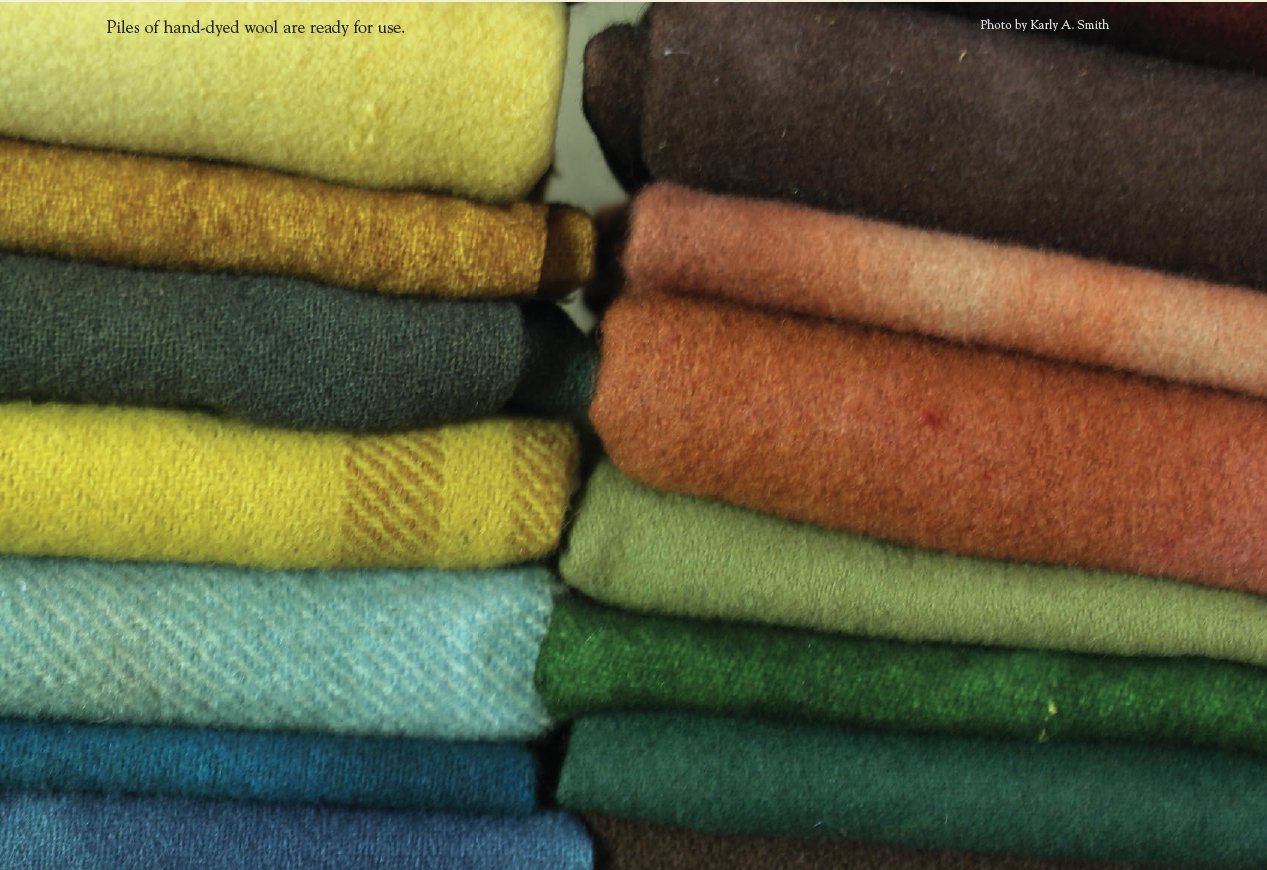 FINDING WOOL In my wool work I use mostly repurposed wool.
FINDING WOOL In my wool work I use mostly repurposed wool.
I obtain it by going to flea markets, thrift stores, auctions, and yard sales and searching for wool that is really no longer wanted in its current condition but can be processed into something useful. I look for wools that are medium weight, which can be dyed or felted to use in appliqu. These are usually in the form of blankets, skirts, jackets, or even old yardage. Keep an eye out for wools that are plain or only slightly patterned. They are the best to use in appliqu. The other thing to watch for is the color.
The lighter the color, the better it is for dyeing or overdyeing. When buying wool, avoid wool that is too heavy or too light in weight and wool that is loosely woven, because it will fray. The other option is to buy wool that is already processed from a wool shop or an individual who sells hand-dyed wools. A growing number of sources are available for those of you who would like to start with wool that is ready to go (see ). PROCESSING YOUR WOOL When I use the term processing, I am referring to the necessary steps to go from woven wool to felted wool that is ready to use. This usually includes felting and dyeing.
I would like to say that I start with a sheep and finish with beautiful woven wool, but that is not the case. Felting Felting is the process of getting the wool to be the right texture for an appliqu project. Some wools felt better than others. The wool fibers must bind together. This keeps the edges from fraying and makes the wool very soft and strong. To felt your wool, follow these three simple steps.
You need a large cooking pot that you will not use for cooking ever again. I recommend this because the commercial dyes are often acid-based. Put in the wool you want to felt and add water to the pot, covering the wool with at least an inch of water. Bring the water to a boil and let the wool simmer for about 20 minutes. All wool is different, and you will have to see how the differing weaves react when boiled. Let the water cool before removing the wool.
Next pageFont size:
Interval:
Bookmark:
Similar books «Wool Appliqué Folk Art: Traditional Projects Inspired by 19th-Century American Life»
Look at similar books to Wool Appliqué Folk Art: Traditional Projects Inspired by 19th-Century American Life. We have selected literature similar in name and meaning in the hope of providing readers with more options to find new, interesting, not yet read works.
Discussion, reviews of the book Wool Appliqué Folk Art: Traditional Projects Inspired by 19th-Century American Life and just readers' own opinions. Leave your comments, write what you think about the work, its meaning or the main characters. Specify what exactly you liked and what you didn't like, and why you think so.

